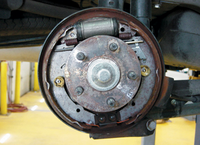








A drum brake is a brake that uses friction caused by a set of shoes or pads that press against a rotating drum-shaped part called a brake drum.
The modern automobile drum brake was first used in a car made by Maybach in 1900, although the principle was only later patented 1902 by Louis Renault. He used woven asbestos lining for the drum brakes lining, as no alternative dissipated heat like the asbestos lining, though Maybach has used a less sophisticated drum brake. In the first drum brakes, levers and rods or cables operated the shoes mechanically. From the mid-1930s, oil pressure in a small wheel cylinder and pistons (as in the picture) operated the brakes, though some vehicles continued with purely mechanical systems for decades. Some designs have two wheel cylinders.
The shoes in drum brakes wear thinner, and brakes required regular adjustment until the introduction of self-adjusting drum brakes in the 1950s. In the 1960s and 1970s, disc brakes gradually replaced drum brakes on the front wheels of cars. Now practically all cars use disc brakes on the front wheels, and many use disc brakes on all wheels. However, drum brakes are still often used for handbrakes, as it has proven very difficult to design a disc brake suitable for holding a parked car. Moreover, it is very easy to fit a drum handbrake inside a disc brake so that one unit serves as both service brake and handbrake.
Early brake shoes contained asbestos. When working on brake systems of older cars, care must be taken not to inhale any dust present in the brake assembly. The United States Federal Government began to regulate asbestos production, and brake manufacturers had to switch to non-asbestos linings. Owners initially complained of poor braking with the replacements; however, technology eventually advanced to compensate. A majority of daily-driven older vehicles have been fitted with asbestos-free linings. Many other countries also limit the use of asbestos in brakes.